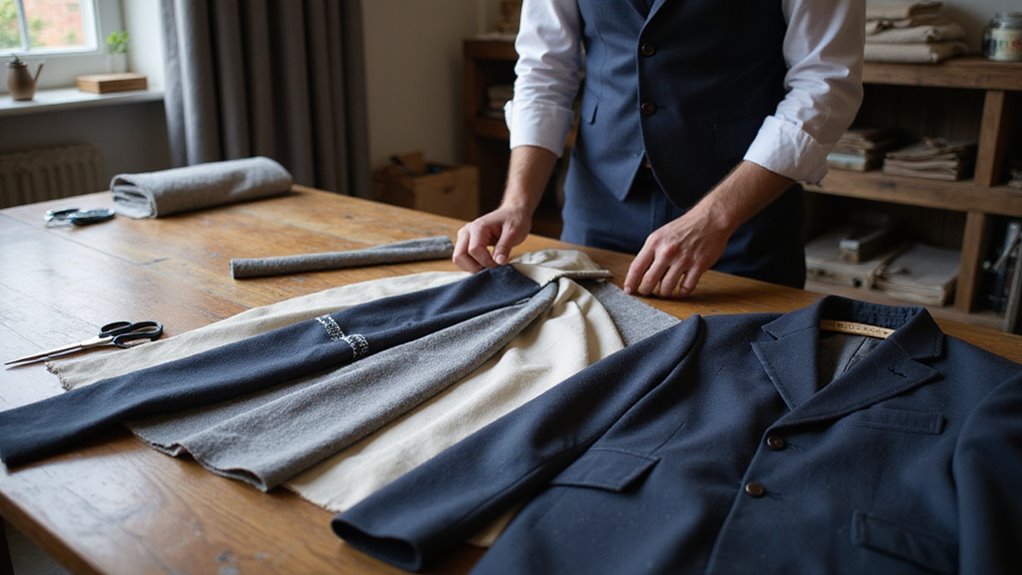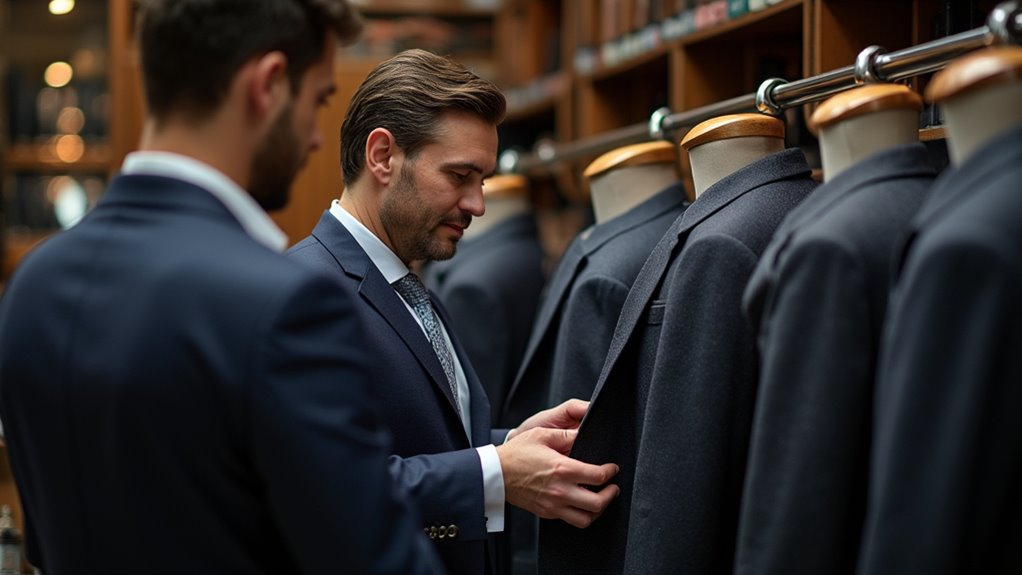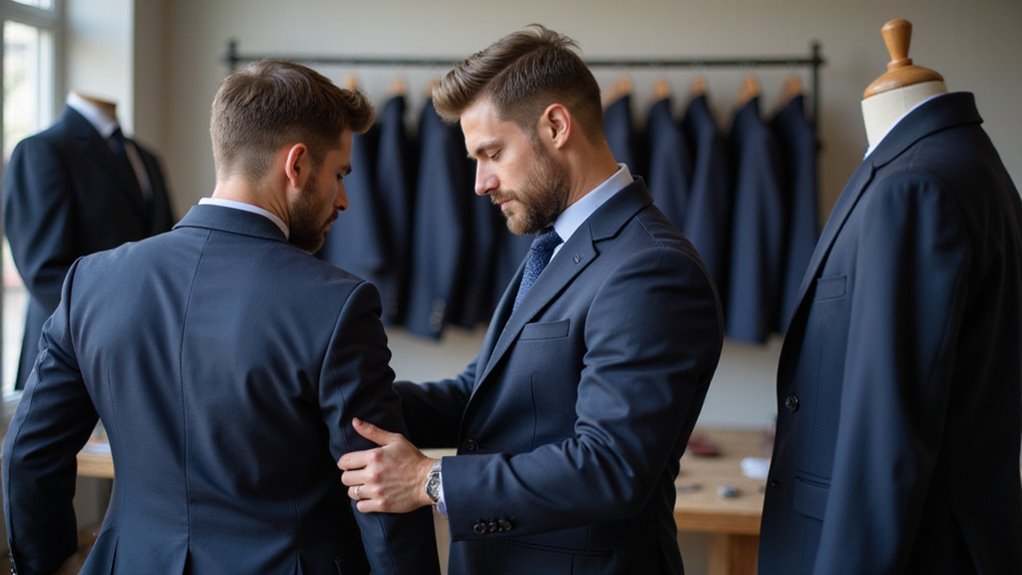Most business professionals want to look sharp, but off-the-rack jackets rarely fit perfectly. The shoulders sag, sleeves are too long, or the jacket feels tight. These small problems can ruin a first impression in the boardroom or at an important meeting.
Wearing an ill-fitting jacket can make you look sloppy or unprepared. People may notice wrinkles, gaps, or bunching around your chest and arms. You might feel uncomfortable throughout the day, and your confidence could suffer as a result.
Custom formal business jackets stand out because they are made to fit your unique shape and style. Skilled tailors measure you and choose materials, ensuring every seam and detail is just right.
You get a look that feels comfortable and polished every time. This blog will guide you through solving poor fit issues with expert tips on custom business jacket tailoring.
Key Takeaways
- Precise body measurements and fitting adjustments ensure a sharp, professional appearance in custom formal business jackets.
- High-quality fabric choices like wool blends provide structure, durability, and breathability appropriate for business settings.
- Customization options include lapel styles, lining materials, button types, and personalized details such as monograms or unique trims.
- The tailoring process involves fabric selection, pattern cutting, multiple fittings, and hand-finishing for optimal fit and craftsmanship.
- Modern custom jackets balance classic business formality with comfortable, contemporary design elements and versatile color palettes.
The Importance of a Well-Fitted Business Jacket

A well-fitted business jacket is important for a professional look. It helps you appear confident and organized at work. The right fit means shoulders align and sleeves end above the wrist bone. The waist should have shape without pulling or extra fabric. Business jackets need careful construction and good fabric, like wool blends. These materials keep their shape and let your skin breathe. Lapels must lie flat and vents should allow easy movement.
Seams should look neat and straight. If you pick the right jacket, you will look polished and set apart from casual styles. Using visual marketing strategies such as mockups can also help you preview and showcase your tailored business jacket before making a final decision. For designers, creating realistic previews using tailoring mockup PSD files ensures you can fine-tune every detail and present your jacket concepts with maximum impact.
Key Differences Between Off-the-Rack and Custom Tailoring
Off-the-rack jackets use standard cuts to fit many people, but they rarely fit perfectly. These jackets may not match your shoulder shape, arm length, or body outline. Factories make the fabric in large amounts, so seam patterns may not line up well. Labels are generic, and you cannot add personal details. Unlike off-the-rack options, custom tailoring emphasizes superior fit and craftsmanship, ensuring a more polished and comfortable appearance.
Custom tailoring uses your exact body measurements. The jacket fits your shoulders, waist, and arms precisely. You can choose the fabric and ask for special pattern matching at the seams. If you want, you can add a monogram or pick a unique lining. Custom tailoring also allows you to select details like peak lapels or button placement, giving your jacket a sophisticated and personalized look.
Selecting the Right Fabric for Your Business Jacket

When you select fabric for your business jacket, weigh the structured drape of wool against the crisp lightness of cotton. Consider how each material performs across seasons—breathable blends for summer, denser weaves for winter. Factor in durability and care, as some textiles resist wrinkling and wear, while others demand more maintenance to retain their sharp appearance.
Digital tools now allow you to visualize the finished look with detailed blazer mockups, making it easier to experiment with colors, patterns, and textures before committing to a final design. For added inspiration, examine how high-resolution images in apparel mockup templates can highlight subtle fabric textures and help you visualize the finished look before making your final choice.
Wool vs. Cotton Choices
Fabric choice affects how your business jacket looks, feels, and lasts. Wool is strong and resists wrinkles. Its tight weave gives your jacket shape and a slight shine. Wool is easy to press and keeps its crisp look.
Cotton has a soft feel and a relaxed fit. It is breathable and comfortable for long wear. Cotton wrinkles quickly and needs frequent care. If you want a sharp, classic jacket, choose wool. If you prefer comfort and casual style, choose cotton.
Seasonal Fabric Considerations
Seasonal fabric choices help you stay comfortable and make your jacket work well. Lightweight fabrics like tropical wool, linen, or cotton keep you cool in warm weather. These materials allow air to flow and help with moisture. Heavier fabrics such as flannel or tweed are good for cold months. They provide warmth and keep a sharp look. Each fabric reacts differently to heat, sunlight, and wear. If you pick the right fabric for the season, your jacket will look good and feel comfortable all year.
Durability and Maintenance
Durability and maintenance are important for any jacket. Wool is a strong fabric that resists wrinkles and daily wear. Tightly woven wool keeps its shape and does not pill easily. You should brush wool gently after each wear and spot clean stains. Cotton and linen need special care; avoid too much water and always use a cloth when ironing.
Proper storage helps jackets last longer. Broad, shaped hangers keep the shoulders in good shape. Garment bags protect jackets from dust and moths while letting air pass through. If you care for your jacket well, it will look good for a long time.
Understanding Jacket Styles and Lapel Options

A jacket’s style and lapel shape decide how it looks and where you can wear it. Jacket cuts include single-breasted, double-breasted, structured, or unstructured styles. Each style changes how the jacket fits and hangs. Lapels shape the neckline and can make you look confident or friendly.
- Notch Lapel: This is simple and works well in most offices.
- Peak Lapel: This style is formal and gives a strong, executive look.
- Shawl Lapel: This is smooth and best for evening events.
- Double-Breasted Cut: This makes shoulders look wider and adds confidence. When selecting a formal jacket, lining material choice can influence comfort, insulation, and the jacket’s suitability for specific climates or occasions.
When preparing jacket visuals for presentations or portfolios, using suit mockup PSD templates can help showcase your designs in a realistic and professional way.
The Role of Measurements in Achieving the Perfect Fit
You’ll notice that every measurement matters when you want your jacket to sit flawlessly across your shoulders, fall to the perfect sleeve break, and contour seamlessly at the waist. Precise tailoring ensures the fabric drapes cleanly, eliminating bunching or pulling that disrupts the jacket’s silhouette. By focusing on these details, you achieve a fit that highlights both craftsmanship and material quality.
Accurate chest and waist measurements are fundamental, as they directly influence how the jacket fits and feels when worn. An essential consideration in tailoring formal jackets is the differentiation from regular suits, as tuxedos are reserved for evening wear and feature unique elements like satin lapels and a matching stripe down the trousers.
Precision in Shoulder Width
Shoulder width is key to how a jacket fits and feels. A custom jacket with the correct shoulder width fits your body well. If the shoulder seam sits at your shoulder bone, the jacket forms neat lines. Good alignment lets the jacket hang naturally and supports good posture.
Proper width spreads out fabric tension and stops creasing. Balanced shoulders help the jacket keep its shape over time. If the fit is wrong, the jacket may bunch or sag.
Sleeve Length Accuracy
Sleeve length accuracy means the jacket’s sleeves end at the right spot near your wrist. This creates a neat, balanced look. Good sleeve length should show about a quarter to half an inch of your shirt cuff. A tailor measures from the shoulder seam to the wrist for best results.
If your posture or arm length is unusual, measurements are adjusted. Buttons on the cuffs must line up with your wrist. Incorrect button placement can make the jacket look uneven. Careful measuring and fabric handling give a sharp, custom fit.
Waist Contour Adjustments
Waist contour adjustments shape the jacket to fit your body well. A good fit avoids pulling or sagging at the waist. Accurate measurement is important for comfort and appearance. The jacket should close easily and look neat. Proper waist shaping also affects sleeve taper and pocket placement.
High-quality fabric can highlight any small errors. If you want a smooth fit, measure your chest, waist, and hips at their widest and narrowest points. Fabric should lie flat in a straight line down the body. Sleeve tapering should match the waist shape. Pocket placement should not bend or stretch with the curves. Careful measuring helps the jacket look sharp and hang correctly.
Personalizing Details: Buttons, Linings, and Stitching
Personalized details make your jacket unique. You can choose buttons made of horn, mother-of-pearl, or metal. Button placement and thread color can highlight your style. Linings come in Bemberg, silk, or satin and affect comfort and weight. Interior trims and pocket linings add subtle style. Hand-pick stitching on lapels or pockets shows skill and strengthens seams.
If you match these features well, your business jacket will stand out. Adding realistic suit visualization through mockup templates can help you experiment with these options before making final decisions. To further ensure your vision is realized, many tailors use custom tuxedo mockups in the design phase, allowing you to preview and adjust these personalized details before finalizing your jacket.
Navigating Color Choices for a Professional Look

To look professional, choose your jacket color carefully. Good color coordination makes your outfit look polished and business-like. Pick a shade that fits your office and flatters your skin tone. Navy, charcoal, and mid-grey work well in most business settings. Always check how the jacket color looks with your shirt and tie.
If you want versatility, use classic colors like navy or grey. Matte wool fabrics make strong colors look softer. Twills and worsteds make colors appear brighter. When matching colors, use the same cool or warm undertones in each piece.
Choosing the right color also depends on whether you’re selecting a sport coat, blazer, or suit coat since each has its own conventions and suitable occasions. Avoid trendy colors if you want your jacket to stay stylish over time. For the most polished appearance, pay attention to accurate colors and fabric texture, as these details create a more professional and realistic impression.
The Tailoring Process: What to Expect
The tailoring process has clear steps. First, you choose your fabric from several options. The tailor then takes your measurements for accuracy. If you have preferences, you can share them at this stage. The tailor creates a pattern based on your body size. Each piece is cut by hand for precision.
You attend a fitting to try on the unfinished jacket. The tailor checks the fit and marks any needed changes. Adjustments are made to improve comfort and appearance. If needed, another fitting may be scheduled. Once everything fits well, the jacket is sewn and pressed.
You receive a finished jacket that suits your body and style. For those seeking even more personalization, you can discuss the level of customization available, which can range from adjustments to existing patterns to creating a completely bespoke jacket.
Common Fit Issues and How Custom Tailoring Solves Them

Common fit issues with jackets include sagging shoulders, tight sleeves, and gaps at the collar. These problems happen when standard sizes do not match your body. Custom tailoring solves this by using your exact measurements. If you want a better fit, a tailor can adjust the jacket for your build. You can also choose how the fabric drapes and how the lapel looks.
- Shoulder seams will line up with your shoulders.
- Sleeve length can show just the right amount of shirt cuff.
- Waist shaping will make your torso look more fitted.
- Collar and neck areas will sit flat, with no gaps.
Custom tailoring lets the jacket fit your body and style perfectly.
Tips for Working Effectively With Your Tailor
Getting a great fit requires clear communication with your tailor. Bring photos of styles you like, both formal and casual. Show examples of your preferred jacket shape or fit. If you like flexible clothing, tell your tailor. They can use stretchy fabrics or add panels for comfort.
Explain how you want the jacket to fit your body. Point out areas needing more movement or support. Discuss fabric types, linings, and finishes. If you need breathable or wrinkle-free options, mention this. Ask for mock-ups or extra fittings if needed. Your feedback on comfort and style helps your tailor make better choices.
Maintaining Your Custom Business Jacket
To keep your custom business jacket in good shape, you need to care for it properly. The right care helps the jacket last longer and keeps it looking new. Different fabrics like wool, linen, or blends need special cleaning and storage methods. If you clean it too often, the fabric may lose its shape or color. Always brush off dust and air the jacket after wearing it.
- Store the jacket on a wide hanger to keep its shape.
- Use a bag that lets air through to protect it from dust and light.
- Clean stains with a damp cloth as soon as they happen.
- Wear different jackets on different days to avoid too much wear.
Proper care will help your jacket stay smart and stylish.
Investing in Quality: Cost Versus Value
Investing in a custom business jacket gives you better value than lower-cost, mass-produced options. You pay for high-quality materials that last longer. Custom tailors often choose fabrics for strength and comfort. They use special dyeing methods so colors stay bright and do not fade easily.
If you want eco-friendly choices, many tailors offer organic fabrics and safe dyes. Skilled workers finish each jacket by hand, making seams strong and patterns neat. If you care about durability and style, a custom jacket keeps its shape and color for years.
When to Choose a Custom Jacket for Business Occasions
Choose a custom jacket for business events when you want to look professional and confident. A custom jacket fits your body perfectly and feels comfortable. Tailors use better fabric than most store-bought jackets. The jacket keeps its shape and looks sharp all day.
If you need to make a strong impression, custom tailoring helps. It shows you care about details and quality. Use a custom jacket for important meetings, presentations, or business dinners.
It is also a good choice if you want personalized touches like monograms or special buttons. Custom jackets make you stand out in high-level business settings. If you value a polished look, custom is the best option.
Trends in Modern Business Jacket Tailoring
Modern business jackets are changing to fit new trends in tailoring. Many now feature slimmer shapes and softer shoulders, which come from casual fashion. Tailors often use lightweight fabrics that stretch and let your skin breathe. These materials include performance wool blends and technical weaves.
Some jackets have partial linings for a relaxed look but still keep sharp lines. Lapels are now more subtle, and patch pockets can give a sporty touch. If you want a clean look, you can choose jackets with hidden closures. New colors like muted blue, olive, and grey are popular. Technical fabrics and sports details make jackets both professional and comfortable.
Conclusion
If you choose a custom formal business jacket, you invest in both comfort and professionalism. Expert tailoring and quality fabrics ensure a perfect fit. A well-made jacket can enhance your confidence at work.
If you take care of your jacket, it will keep its sharp look for years. Regular cleaning and proper storage can preserve its shape and fabric. Your jacket will continue to reflect your ambition.
If you want to see how a custom jacket suits you, try a Custom Mockup. This tool can help you visualize your options. Start your journey toward the perfect business jacket today.



No Comment! Be the first one.